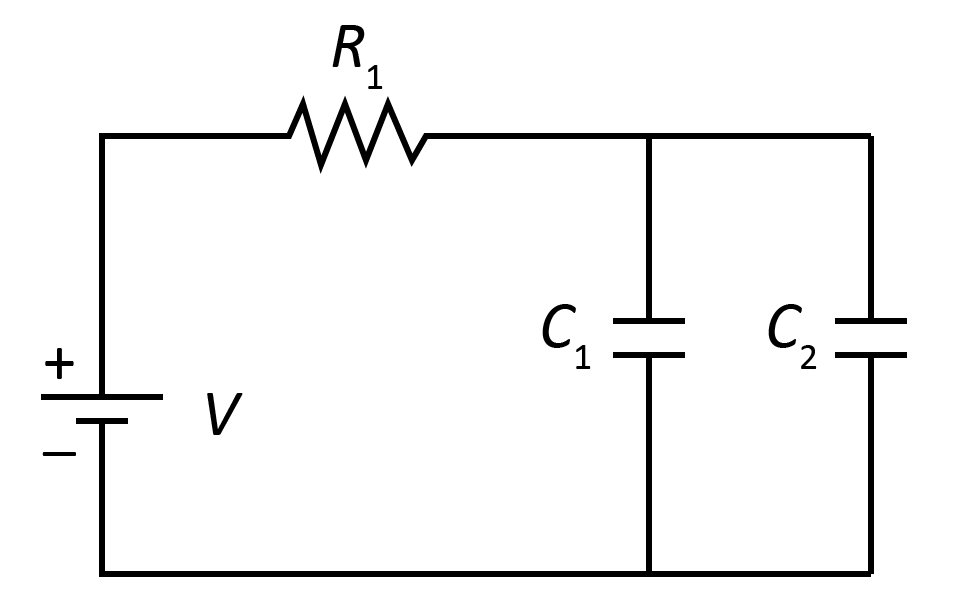
A circuit contains two capacitors in parallel wired in series to a resistor and source as shown above. The capacitors are initially uncharged. Which of the following describes the current I through and voltage $V_c$ across the Capacitor $C_1$ after the circuit reaches steady state?

A) I=0 , ${V_c}$=0
B) I=0,${V_c}$=V
C) I=0, ${V_c}$=V/2
D) I=V/R, ${V_c}$=0
E) I=V/R, ${V_c}$=V
Answer
165k+ views
Hint: Experimentally the time taken for a capacitor to get completely charged is equal to t=RC where t is the time constant in charging of the capacitor in C-R circuit, R is the resistance of the resistor in series and C is the capacitance of the capacitor. From this we can conclude that adding a resistance in series will increase the time taken by the capacitor to get fully charged.
Complete step by step answer:
A capacitor is a charge storing device. It is connected to a resistor initially and charged through a battery. The charging process is time dependent and it takes some time depending on the RC value of the circuit for the capacitor to reach maximum charge. But since we are leaving the capacitor connected for a long time, we assume that it is storing its maximum charge.
A capacitor connected across a DC supply keeps on charging till the potential across the battery becomes equal to the potential difference across the capacitor. In steady state after some time the current in the circuit will numerically be equal to zero. Hence we will use Kirchhoff’s law of voltage to see in steady state the potential difference across the capacitor.
Therefore, I=0, ${V_c}$=V and the correct option is (B).
Note: In an RC circuit, if the source is DC, the current then decreases from its initial value of I to zero as the voltage of the capacitor reaches the same value as the emf in case of transient period i.e. for a very short time in microseconds. As we know capacitors block the DC current, meaning the circuit will act as an open circuit.
Complete step by step answer:
A capacitor is a charge storing device. It is connected to a resistor initially and charged through a battery. The charging process is time dependent and it takes some time depending on the RC value of the circuit for the capacitor to reach maximum charge. But since we are leaving the capacitor connected for a long time, we assume that it is storing its maximum charge.
A capacitor connected across a DC supply keeps on charging till the potential across the battery becomes equal to the potential difference across the capacitor. In steady state after some time the current in the circuit will numerically be equal to zero. Hence we will use Kirchhoff’s law of voltage to see in steady state the potential difference across the capacitor.
Therefore, I=0, ${V_c}$=V and the correct option is (B).
Note: In an RC circuit, if the source is DC, the current then decreases from its initial value of I to zero as the voltage of the capacitor reaches the same value as the emf in case of transient period i.e. for a very short time in microseconds. As we know capacitors block the DC current, meaning the circuit will act as an open circuit.
Recently Updated Pages
Transistor as Amplifier: Working, Diagram, Uses & Questions

Moving Charges and Magnetism: Laws, Formulas & Applications

Environmental Chemistry Chapter for JEE Main Chemistry

Difference Between Capacitor and Inductor: JEE Main 2024

Electrostatics for JEE Main Physics 2025: Concepts and Applications

JEE Main Mathematics Integral Calculus Concepts and Tips for Exam Preparation

Trending doubts
JEE Main 2025 Session 2: Application Form (Out), Exam Dates (Released), Eligibility, & More

Electric field due to uniformly charged sphere class 12 physics JEE_Main

Uniform Acceleration

Atomic Structure - Electrons, Protons, Neutrons and Atomic Models

Displacement-Time Graph and Velocity-Time Graph for JEE

JEE Main 2025: Derivation of Equation of Trajectory in Physics

Other Pages
JEE Advanced Marks vs Ranks 2025: Understanding Category-wise Qualifying Marks and Previous Year Cut-offs

JEE Advanced Weightage 2025 Chapter-Wise for Physics, Maths and Chemistry

Learn About Angle Of Deviation In Prism: JEE Main Physics 2025

Degree of Dissociation and Its Formula With Solved Example for JEE

Electric Field Due to Uniformly Charged Ring for JEE Main 2025 - Formula and Derivation

Wheatstone Bridge for JEE Main Physics 2025




